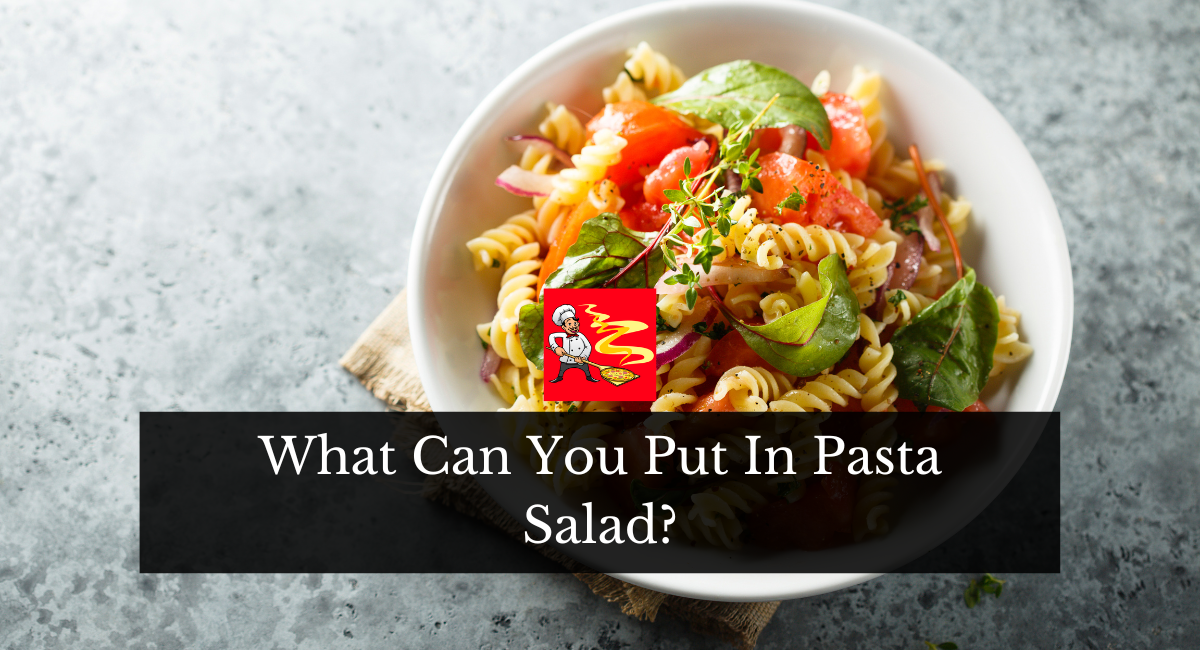Pasta salad, a versatile and beloved dish, serves as a canvas for a myriad of ingredients. The possibilities are virtually endless, from the type of pasta used to the variety of mix-ins and dressings.
Whether you’re aiming for a refreshing summer side or a hearty main dish, your ingredients choices can transform your pasta salad.
This article delves into a plethora of options you can incorporate, ensuring every bite is a delightful surprise.
What Can You Put In Pasta Salad?
Pasta salad is a versatile dish that can be tailored to fit any taste or occasion. Its adaptability means you can incorporate a wide range of ingredients, from vegetables and meats to cheeses and dressings. Here’s a comprehensive list of potential additions to elevate your pasta salad:
1. Pasta Choices
- Penne: This tube-shaped pasta is great for holding onto chunky sauces and ingredients.
- Fusilli: The spirals or twists of fusilli are perfect for capturing both creamy and vinaigrette dressings.
- Farfalle (bow-tie): Its unique shape and ridges make it ideal for salads with larger ingredients.
- Rotini: Similar to fusilli but with a tighter spiral, it’s excellent for chunky vegetable salads.
- Macaroni: A classic choice, especially for creamy salads.
- Orzo: Resembling large grains of rice, orzo offers a different texture and is great for Mediterranean-style salads.
- Tortellini: Filled pasta that can add an extra layer of flavor, especially when paired with simple dressings.
2. Vegetables
- Bell peppers: They add a sweet crunch and a burst of color.
- Olives: Kalamata olives, for instance, can add a salty and tangy flavor reminiscent of Mediterranean dishes.
- Broccoli or cauliflower: Best blanched or steamed slightly to soften their texture while retaining a bite.
- Artichoke hearts: Marinated artichoke hearts can introduce a tangy and slightly briny flavor.
3. Proteins
- Grilled chicken: Seasoned and grilled chicken can add a smoky flavor.
- Tuna: Freshly grilled tuna steaks, flaked into the salad, can elevate it to a more gourmet level.
- Hard-boiled eggs: They provide a creamy texture and are a classic addition to many salads.
- Chickpeas: A great vegetarian protein source, they also add a nutty flavor.
4. Cheeses
- Feta: Crumbly and tangy, feta cheese pairs well with Greek-style salads.
- Mozzarella: Fresh mozzarella balls (bocconcini) can add a soft, milky texture.
- Parmesan: Shavings of Parmesan can introduce a salty and umami flavor.
5. Fruits
- Apples: They add a sweet crunch. Opt for green apples if you prefer a tart flavor.
- Pineapple chunks: These can introduce a tropical twist, especially when paired with seafood.
6. Nuts & Seeds
- Sliced almonds: Toast them lightly for an enhanced nutty flavor.
- Sunflower seeds: They offer a crunchy texture and are packed with nutrients.
7. Herbs & Spices
- Fresh basil: It can infuse the salad with a peppery and slightly sweet flavor.
- Dried oregano: A staple in Italian cooking, it adds a robust and earthy flavor.
8. Dressings
- Olive oil and lemon juice: This simple dressing is light and refreshing, perfect for summer salads.
- Pesto: Basil pesto can add a rich, herby, and nutty flavor.
9. Extras
- Pickles: Chopped dill pickles can introduce a tangy crunch.
- Anchovies: These can be polarizing, but if you love a deep, salty, and umami flavor, they’re a great addition.
Additional Tips:
- Mixing Textures: The interplay of textures—crunchy veggies, soft pasta, creamy cheese—can make your pasta salad more enjoyable.
- Seasoning: Don’t forget to season your pasta water. It’s the foundation of your dish, and well-seasoned pasta can make a significant difference.
- Freshness: If you’re using herbs, fresh ones can make a world of difference in flavor. If you’re using dried herbs, ensure they haven’t been sitting in your pantry for ages.
What Are The Five Mistakes To Avoid Pasta Salad?
Five common mistakes to avoid when making pasta salad are:
- Overcooking pasta: Cook pasta al dente to prevent it from becoming mushy.
- Underseasoning: Be generous with salt and seasonings to ensure flavor.
- Not cooling pasta properly: Rinse pasta with cold water after cooking to stop it from overcooking and sticking.
- Overcrowding with ingredients: Balance pasta and other ingredients for even distribution.
- Not letting it chill: Allow the pasta salad to chill in the fridge for flavors to meld before serving.
Do You Eat Pasta Salad Warm Or Cold?
Pasta salad can be enjoyed either warm or cold, depending on personal preference and the recipe. Many people prefer it chilled, as it allows the flavors to meld together, making it a refreshing side dish or main course, especially in warm weather.
However, some recipes call for serving it warm, often as a main course with freshly cooked pasta and warm ingredients. Ultimately, the choice between warm and cold pasta salad depends on your taste and the recipe you’re using.
Bottom Line
The beauty of pasta salad lies in its adaptability. From crisp vegetables, savory cheeses, and succulent meats to a range of dressings from creamy to zesty, the combinations are boundless. By understanding the interplay of textures and flavors, you can craft a pasta salad that’s both balanced and bursting with taste.
Whether you stick to classic combinations or venture into uncharted culinary territories, pasta salad remains a testament to the magic of mixing and matching in the kitchen.
Also read: What To Serve With Pasta Salad As Main Course?

